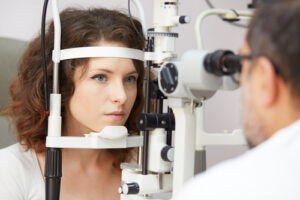If you’re 40 years of age or older, you could already have a mild cataract and not even know it!
Cataracts most commonly occur as a normal part of aging. They take years, if not decades, to form and develop. You may wonder if there is anything you can do to reduce your risk of developing cataracts.
There’s no way to guarantee that you’ll never develop cataracts, but there are a few things you can do to reduce your risk of developing them early.
Stay healthy and fit

At any age, it’s important to lead a healthy lifestyle and stay fit.
It is recommended to include physical activity to increase the heart rate enough to start sweating at least 3-4 times per week for 30 minutes at a time.
Eat leafy green vegetables and fruits
Leading a healthy lifestyle includes keeping a balanced diet which includes plenty of vegetables and fruits.

Your eyes may benefit the most from the following foods, which are high in antioxidants:
- Broccoli
- Red and green bell peppers
- Spinach
- Kale
- Brussels sprouts
- Citrus fruits such as oranges and grapefruit
- Kiwi
- Strawberries
In addition, a balanced diet rich in Vitamin C, E, lutein, and zeaxanthin may slow the development of cataracts. These can be found in green leafy vegetables, such as kale and spinach, as well as eggs.
Multivitamins and supplements can help increase your intake of these vitamins and minerals.
Before making any dietary changes, it is important to talk to your doctor first.
Get an eye exam

The American Academy of Ophthalmology recommends a baseline eye exam for adults with no symptoms or risk factors at age 40. A dilated eye exam is almost always done during the baseline eye exam.
Risk factors include diabetes, high blood pressure, or a family history of eye disease. A history of an eye injury may also increase the risk of eye disease. These patients may need to be seen sooner than age 40.
Your ophthalmologist will recommend how often to follow up depending on your medical history, family history, and baseline eye exam. Detection and monitoring of eye disease are important to prevent vision loss.
Don’t smoke

Smoking is bad for your health, including your eyes. Smoking increases your risk of developing cataracts, as well as age-related macular degeneration, or AMD.
AMD causes damage to the macula part of the retina and affects the central part of the vision. Former smokers are also at increased risk of developing AMD.
Smokers are also more likely to develop dry eye syndrome, which causes your eyes to feel dry, itchy, irritated, watery, and can cause blurry vision.
If you have diabetes, you are at risk of developing diabetic retinopathy which can lead to severe vision loss if not detected early and treated. There is an even higher risk of diabetic retinopathy if you have diabetes and also smoke.
In diabetic retinopathy, blood vessels in the eye are damaged. There is also an increased risk of developing glaucoma in people with diabetes, especially those who smoke.
Glaucoma occurs due to optic nerve damage. It is considered a “silent thief of sight” because early symptoms may not be detected by the patient and only becomes symptomatic when the disease is very advanced.
The vision loss that occurs in glaucoma is irreversible. Thus, it is important to detect, treat, and monitor glaucoma early.
The bottom line: if you are a smoker, quit smoking to avoid or reduce your risk of developing these eye conditions which can lead to vision loss.
Protect your eyes from the sun

In the summer, it may seem like second nature to wears sunglasses before going outside. However, this should be second nature all year long, no matter what season!
Protecting your eyes from the sun with UV protection in sunglasses is an easy way to slow the development of cataracts. The sunglasses should protect against both UV-A and UV-B rays by blocking 99-100% of UV light from the sun. Look for a label on your sunglasses to confirm this.
Sunglasses should also screen out 75-90% of visible light. The fit of the frame is important and should be close to your eyes and the contour of your face.
A wide-brimmed hat also provides sun protection for your eyes and your face, ears, and neck. It never hurts to be overprepared, no matter the season!
Wondering if you have cataracts? Schedule a cataract screening at the New England Eye Center at one of our offices in the greater Boston area!
